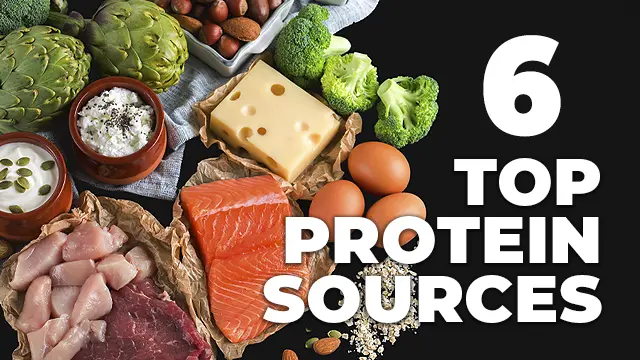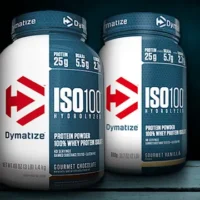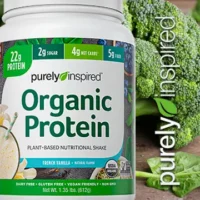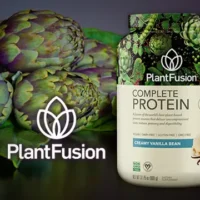BACK
Six top protein sources
While any source of protein will be utilized by the body, some are more beneficial than others. So here are six top protein sources.

As one of the three key macronutrients, protein is an important part of our diets. It plays a role in so many aspects of our health that we’d need a few other articles just to list them all!
As protein is so vital to our diets, it’s essential that we choose sources that are beneficial to our health and fitness goals. While any source of protein will be utilized by the body, some sources come with more benefits than others. Below are six of the best options for fulfilling your protein needs.
As protein is so vital to our diets, it’s essential that we choose sources that are beneficial to our health and fitness goals. While any source of protein will be utilized by the body, some sources come with more benefits than others. Below are six of the best options for fulfilling your protein needs.

TEMPEH
Surprised to see a fermented soy product at the top of the list? This traditional fermented soy food packs a protein punch, with over 5g per ounce - nearly twice its own level of carbohydrates.
It’s also a low-fat option, which makes it perfect for getting good quality protein without the saturated fats so often seen in red meat. High in calcium and reported to be great for gut health, tempeh is best prepared with delicious sauces, marinades, herbs, and spices.
It’s also a low-fat option, which makes it perfect for getting good quality protein without the saturated fats so often seen in red meat. High in calcium and reported to be great for gut health, tempeh is best prepared with delicious sauces, marinades, herbs, and spices.
Protein
5.1
per ounce
Carbs
2.6
per ounce
Fat
3.2
per ounce

EGGS
Eggs are an easy go-to option for protein. They can be prepared in a number of ways, and provide a good source of calcium and Vitamin A.
Eggs do have a bad reputation for containing saturated fats and cholesterol and frying up an omelet or scramble will only add to those levels. It’s best to make sure your egg intake is balanced with a healthy dose of fiber and fresh vegetables.
As anyone who has backyard chooks knows, fresh eggs taste best, and for those with an ethical slant, home-laid eggs are a kinder option than the caged variety.
Eggs do have a bad reputation for containing saturated fats and cholesterol and frying up an omelet or scramble will only add to those levels. It’s best to make sure your egg intake is balanced with a healthy dose of fiber and fresh vegetables.
As anyone who has backyard chooks knows, fresh eggs taste best, and for those with an ethical slant, home-laid eggs are a kinder option than the caged variety.
Protein
3.5
per ounce
Carbs
0.3
per ounce
Fat
3.0
per ounce

PROTEIN POWDERS
It’s common knowledge that most of your nutrients should come from a healthy diet. Like other vitamin and mineral supplements, protein powders are designed to be an addition to good quality food.
Having said that, protein powders can play a very useful role in many diets, particularly for people who have a higher requirement such as athletes. Protein powders are a tasty and convenient way of ensuring you get enough protein, and can be taken alone as a shake, or added to other recipes to increase the protein content.
The example content below is an average whey-based protein powder, though protein, carb, and fat content can vary between products.
Having said that, protein powders can play a very useful role in many diets, particularly for people who have a higher requirement such as athletes. Protein powders are a tasty and convenient way of ensuring you get enough protein, and can be taken alone as a shake, or added to other recipes to increase the protein content.
The example content below is an average whey-based protein powder, though protein, carb, and fat content can vary between products.
Protein
5.1
per ounce
Carbs
2.6
per ounce
Fat
0.5
per ounce

BROCCOLI
A super healthy option, broccoli comes packed with heaps of fiber and antioxidants. While it’s lower in protein than other foods, broccoli is on par with eggs for calcium and Vitamin A.
Broccoli isn’t a food you’d use as a primary source of protein, as you have to eat a lot of it to get a reasonable amount. As a vegetable, it stands out though with 20% protein content. Eating this nutritious green in addition to your other protein sources will ensure you’re getting high levels of nutrition along with your protein needs.
Broccoli isn’t a food you’d use as a primary source of protein, as you have to eat a lot of it to get a reasonable amount. As a vegetable, it stands out though with 20% protein content. Eating this nutritious green in addition to your other protein sources will ensure you’re getting high levels of nutrition along with your protein needs.
Protein
0.8
per ounce
Carbs
1.9
per ounce
Fat
0.1
per ounce

OATS
As far as grains go, oats are one of the healthiest. Even though they are much higher in carbohydrates than other options, they still provide 3.7g of protein per ounce.
High in fiber, folate, magnesium, and phosphorus, oats are a great source of protein for those who want to increase calories for bulking or simply maintain a healthy gut. By adding milk, soy milk, nuts, seeds, or protein powder to a bowl of oats, the protein content is increased even further - and so is the taste!
High in fiber, folate, magnesium, and phosphorus, oats are a great source of protein for those who want to increase calories for bulking or simply maintain a healthy gut. By adding milk, soy milk, nuts, seeds, or protein powder to a bowl of oats, the protein content is increased even further - and so is the taste!
Protein
3.7
per ounce
Carbs
19.3
per ounce
Fat
1.8
per ounce

LEAN MEAT
Well-known throughout the bodybuilding world, lean meats are the most commonly recognized source of protein.
Beef, chicken, and turkey often feature highly in weight loss and fitness diets, as meat tends to have greater levels of protein and very low carbohydrate content.
With increasing health and environmental concerns surrounding meat, it’s best to ensure you buy these products from producers who avoid hormones and genetically modified feeds. While meat is an excellent source of protein, it’s recommended you balance your intake with fiber-rich foods, to ensure the health of your gut.
Beef, chicken, and turkey often feature highly in weight loss and fitness diets, as meat tends to have greater levels of protein and very low carbohydrate content.
With increasing health and environmental concerns surrounding meat, it’s best to ensure you buy these products from producers who avoid hormones and genetically modified feeds. While meat is an excellent source of protein, it’s recommended you balance your intake with fiber-rich foods, to ensure the health of your gut.
Protein
8.3
per ounce
Carbs
0
per ounce
Fat
1.8
per ounce
The nutritional profile of lean meats varies based on the meat type. The example nutritional profile provided above is based on roasted chicken breast.
Choosing a Source
Almost every food available to us contains some level of protein, but of course, some are richer sources than others. By eating a variety of nutritious and protein-rich foods, you can maintain excellent levels of protein regardless of your health needs.
Try experimenting with different meals and remember that diversity in food means a greater range of vitamins and minerals, which are just as important as your protein intake. The six options listed here are a great start, so why not explore the huge range of meals you could prepare with them?
Try experimenting with different meals and remember that diversity in food means a greater range of vitamins and minerals, which are just as important as your protein intake. The six options listed here are a great start, so why not explore the huge range of meals you could prepare with them?
Popular Reviews
The content on this site has not been written, reviewed or endorsed by a medical professional. We assume no liability for the misuse of supplements and recommend you review the label of any product, as well as consulting with your health care professional.
We are a participant in the Amazon Services LLC Associates Program, an affiliate advertising program designed to provide a means for us to earn fees by linking to Amazon.com and affiliated sites.
We are a participant in the Amazon Services LLC Associates Program, an affiliate advertising program designed to provide a means for us to earn fees by linking to Amazon.com and affiliated sites.
© 2025 ProteinPowder.com




